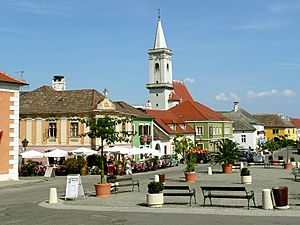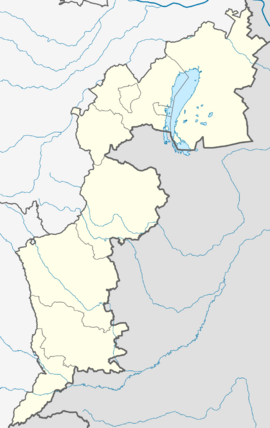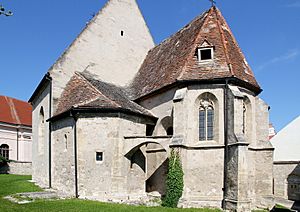Rust, Burgenland facts for kids
Quick facts for kids
Rust
|
||
|---|---|---|

Main square in Rust
|
||
|
||
| Country | ||
| State | Burgenland | |
| District | Statutory city | |
| Area | ||
| • Total | 20.01 km2 (7.73 sq mi) | |
| Elevation | 123 m (404 ft) | |
| Time zone | UTC+1 (CET) | |
| • Summer (DST) | UTC+2 (CEST) | |
| Postal code |
7071
|
|
| Area code | 02685 | |
| Vehicle registration | E | |
| Website | www.freistadt-rust.at | |
Rust (German pronunciation: [ʁʊst]; Croatian: Rušta; Hungarian: Ruszt) is a small city in Austria. It is located in the state of Burgenland. You can find it on the western side of Lake Neusiedl, close to the border with Hungary.
Rust is special because it is Austria's smallest statutory city. This means it has its own local government, like a district. It was given this important status by the Hungarian crown in 1681. The city is very well known for its delicious wines. Some famous types include Beerenauslese, ice wine, and especially Ruster Ausbruch.
A Look at Rust's History
Rust was first mentioned in a document in 1317. This document was written by King Charles I of Hungary. The city's name, Ceel, came from the Hungarian word szil, which means "Elm tree". Later, this was translated into the German words Rüster or Rusten, which also mean elm. Today, the Hungarian name Ruszt is a translation from the German name.
The people of Rust got special market rights in 1470. This meant they could hold markets and trade goods. In 1524, they received another important privilege. They were allowed to mark the corks of their wine barrels with a special 'R' brand. This showed that the wine came from Rust.
The city became very wealthy and important. In 1681, Emperor Leopold I, who was also the King of Hungary, declared Rust an independent city. This happened at a big meeting called the diet in Sopron.
Later, in 1921, the Burgenland region, including Rust, became part of the Republic of Austria. Before that, it was part of Hungary.
Cities Rust is Connected To
Rust has special connections with other cities around the world. These are called "twin towns" or "sister cities". They often share culture and friendship.
Rust is twinned with:
 Kulmbach, a city in Germany. They became twin towns in 1981.
Kulmbach, a city in Germany. They became twin towns in 1981. Tokaj, a city in Hungary. They became twin towns in 2006.
Tokaj, a city in Hungary. They became twin towns in 2006.
See also
 In Spanish: Rust (ciudad) para niños
In Spanish: Rust (ciudad) para niños






